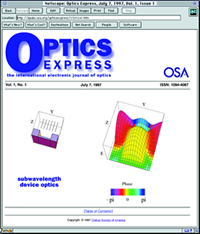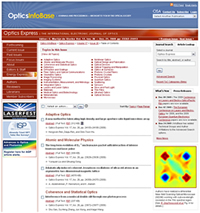In the mid-90s when leaders of Optical Society of America decided to launch an  open-access publication, the term “Open Access” hadn’t yet been coined. Nor had much of the technology needed to make it happen been developed. But that didn’t deter the society from moving forward.
open-access publication, the term “Open Access” hadn’t yet been coined. Nor had much of the technology needed to make it happen been developed. But that didn’t deter the society from moving forward.
The first issue of Optics Express was posted online July 7, 1997. It was an innovative concept and one in which the founding editor, Dr. Joseph Eberly, broke new ground with each step. From setting up a near lightning-speed process of peer review to finding a browser that worked, the early group of scientists that established the open-access journal was farsighted.
“You have to remember, the people who were involved in this project are experimenters,” says Dr. John Childs, senior director of publications at OSA. “They like thinking of ideas and seeing them work.”
And work it did. OSA pioneered a new model for scholarly publishing that has been embraced by the scientific community it serves, and a financial success. Optics Express is a top-ranked journal in its field, along with OSA’s other traditional journal Optics Letters. It publishes original, peer-reviewed articles in all fields of optical science and technology twice a month. In 2009 among all publications, it was ranked 15th in terms of the number of papers published, according to the Journal Citation List by ISI.
“Through the efforts of many people, we built something very unique that came together. It was really a question of synchronicity – not any one thing, but everything was right as it turned out,” says Childs.
SPARC named Optics Express a Leading Edge partner in 2004, recognizing it for being one of the first open-access journals managed by a traditional academic society with a sustainable business model. “It’s a stellar example of how to do it right,” says Rick Johnson, former executive director of SPARC. “It achieved success for the society and the journal itself.”
It is a testament to the fact that Open Access can be a viable commercial option, says current SPARC Executive Director Heather Joseph. “Initially, Optics Express was viewed as an experiment, but it has become a highly regarded journal and a popular destination for manuscripts,” she says. “The financial success it has achieved is just the icing on the cake.” Optics Express offers authors rapid electronic publication – averaging 47 days – and supports the inclusion of color images and multimedia files at no additional cost.
The approach is so profitable for OSA that Childs sees it as the wave of the future – possibly a model for all of the society’s journals. The society will be rolling out three more open-access journals over the next year using Optics Express as the template.
The early visionaries

From left: Joe Eberly, Michael Duncan, Martijn de Sterke, John Childs
It all began at an OSA leadership meeting in San Francisco in 1994 when members were sitting around tables brainstorming about new initiatives. The notion of electronic publishing was endorsed as a top priority and there was a feeling that the society needed to do something on the Internet. “I found myself blurting out: We could publish a journal,” says Eberly, then a member of the Society Objectives and Policy Committee of OSA. “I ended up with a job to do.”
Eberly, Carnegie Professor of Physics and Professor of Optics at the University of Rochester and director of the Rochester Theory Center, served as editor-in-chief of Optics Express for its first five years. From the outset, the journal was all about speed. Eberly insisted on a quick turnaround, giving reviewers just two weeks to review papers and authors two weeks for revisions. “We were guaranteeing from receipt of a manuscript to publication, seven weeks. At that time, seven months was normally fast,” says Eberly. “That was the reason it took off.”
The new format required a new peer-review model. Eberly tapped into his network of research scientists around the world and drafted them to help with the start-up process. They served as trial editors, authors, reviewers and transmitters of the journal to refine the system.
The move online also changed the editing process. Now authors had to do their own formatting and copyediting. “Everyone was accustomed to a copy staff at the journal that would fit it and make them look good,” recalls Eberly. “[Authors] had to do it themselves. That was a barrier that had to be overcome.” But it was also a change that saved time and money.
Because Optics Express is available to anyone for free online, there is no subscription income. And, at first, there were no author fees. After about a year, the journal started charging $300 to authors to post an article to cover some costs. Prices have gradually increased and today are $925 for six or fewer pages and $1,585 for 7 to 15 pages.
“Joe was very insightful and encouraging to us to go into this area,” says Deborah Herrin, senior director of information technology at OSA who was on the ground floor helping launch Optics Express. Although it was online, Eberly insisted on a “cover” to the journal. “We thought he was crazy,” recalls Herrin. But, as it happens, adding a cover – an entry page with an image – was a great idea. Authors wanted to have their work featured on the cover and it became a cornerstone of the journal, she says. Moreover, from the beginning a cover image has typically been a short movie, extracted from an article in the issue.
At first, Optics Express needed to attract attention and Eberly thought it could do this by publishing articles by well-known authors. So, he came up with the idea of Focus issues. A single person was delegated to identify a hot topic of interest, invite up to 12 authors to contribute on the chosen topic and set a near-term target date for delivery of articles, to convey a sense of urgency. “The authors knew that only a few invitations were being offered and that their main competitors were also getting invitations,” he says. “So they generally accepted the invitation.”
Herrin said that approach helped boost the journal’s impact scores. “It brought in high caliber people from the start,” she says.
Dr. Michael Duncan, who worked on the journal as an associate editor and became its second editor-in-chief, credits Eberly with the Focus issues and speed of publication as the “brilliant ideas” that led to Optics Express becoming the journal of choice for many.
“Joe was pushing something that was outside of the comfort zone of what OSA had done before. It was exciting,” says Duncan, a research physicist at the U.S. Naval Research Laboratory. “The tenor of the time was that information was going to be free. We were doing something simpler, easier and getting information out better.”
Moving into the black
If Eberly saw the journal through its infancy, it was Duncan who took it through its teen years when policies were formalized, processes solidified and the quality improved, says Herrin.
As the journal grew, there were more resources to spend on better quality control with copy editing, says Duncan. Since the journal was being inundated with submissions, he also tightened editorial controls. The rejection rate increased, but still more papers were being accepted than turned away.
Under Duncan’s editorship, Optics Express started to turn a profit in 2004. Often editors are insulated from the working of the business side, but Duncan said at the time many working on the journal felt they had a vested interest not just in the editorial content, but also ownership in the business model. Yet, he and other editors became so busy with the journal that they disengaged from the business side. There was a “huge satisfaction” is seeing the journal start making money, he says, but his focus was on getting good content out fast.
Authors relished how quickly their research results were made available to the world for free. The more papers they published, the more their visibility, reach and citations went up. “It fed on itself,” says Duncan. “It was a cycle. People were adopting this way of doing things – hence we became as highly ranked as Optics Letters, which was astonishing.”
At the same time Optics Express was becoming profitable, it also was growing exponentially. By 2005, it was four times the size that it had been in 2001, measured by published pages. From 2004 to 2005, submissions increased by 60 percent. It started to snowball,” recalls Childs.
Duncan says Childs aided the rapid expansion. “John did the magic with his business acumen to make it work internally,” says Duncan.
Although OSA marketed the journal, Childs doesn’t credit its growth to advertising. Polling has shown that it’s the speed at which research is published that has drawn people to the journal. It was also one of the first to develop multimedia in the text of a journal. And then there is the fact that it’s free. “Being open-access – where everyone in the world could read it and cite it – was a factor,” he says.
Keeping the journal moving forward – and expanding
Today, Optics Express continues to expand. Now there are 60 associate editors and Dr. Martijn de Sterke, professor in physics at the University of Sydney, has served as editor-in-chief since 2007. “This is the way to run a journal,” says de Sterke. “If I had to start a new journal from scratch, this is how I would do it.”
About 90-100 papers are submitted online each week for review and about 60 percent are accepted, says de Sterke. The journal continues to publish every two weeks. “It’s a good, no nonsense journal,” he says. “It’s no longer some kind of niche journal. It’s one of the biggest ones.”
How profitable is Optics Express today? The net surplus that OSA earns from Optics Express is equal to the net it earns from the biggest earning traditional subscription journal, says Childs. The income spills over to fund other society activities, such as student outreach and its foundation. Its success funds new journal innovation.
The open-access approach seems to make so much sense – and is so lucrative – that OSA is introducing three new journals under the Optics Express brand over the next year: Biomedical Optics Express, Optical Material Express and Energy Express.
 “We use Optics Express as a harbinger, a model for what I think is probably going to come to pass,” says Childs. Although he plans to retire this year and return to teaching, he hopes to remain active in consulting on new publishing models.
“We use Optics Express as a harbinger, a model for what I think is probably going to come to pass,” says Childs. Although he plans to retire this year and return to teaching, he hopes to remain active in consulting on new publishing models.
So, is Childs an open-access advocate? “I’m an open-access pragmatist. I really look at what will work,” says Childs. “I’m fairly certain that the old models of publishing won’t exist in 10 years.” Childs says a new approach might be to reduce authors’ fees and share the financial load with other stakeholders, such as universities and foundations. Indeed, the open-access model used today may be modified beyond what we can imagine, he says.
-by Caralee Adams